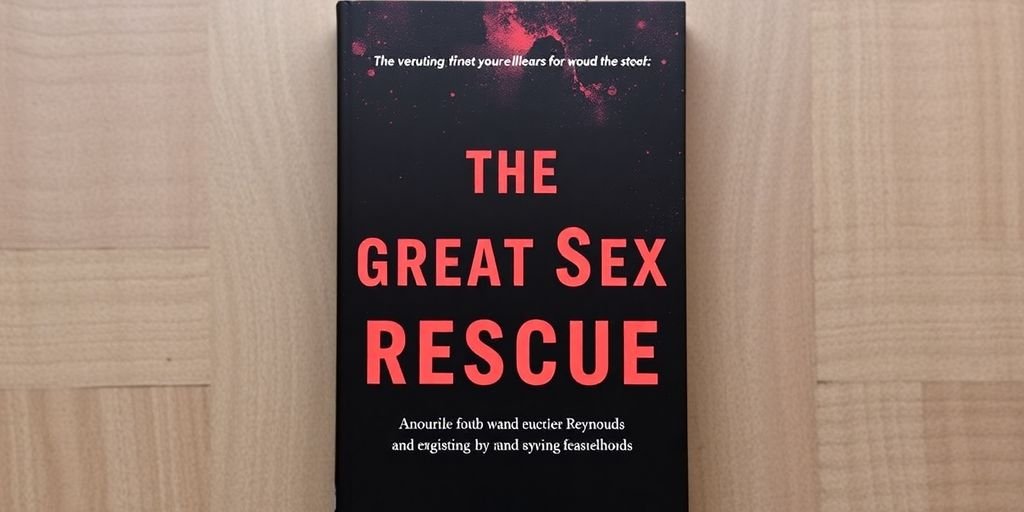So, I’ve been looking into this book, ‘The Great Sex Rescue,’ and wanted to share what I found. It’s all about the messages surrounding sex within some Christian circles, particularly evangelical ones. The author, Sheila Wray Gregoire, really digs into what many women have been taught about sex and offers a different perspective. It seems like a big conversation starter, and I’m trying to break down the main points here, focusing on the great sex rescue summary.
Key Takeaways
- The book challenges common teachings in evangelical communities that often place the wife’s responsibility on her husband’s sexual satisfaction and his potential temptation.
- It highlights survey data from thousands of women, revealing widespread dissatisfaction and harmful messages about sex they received.
- Gregoire presents faith-based ideas for sex that prioritize mutual pleasure, emotional connection, and consent.
- Practical advice is offered for couples to understand and communicate desires, overcome sexual difficulties, and build intimacy.
- The book aims to help individuals find healing from past issues and achieve a more fulfilling sexual life within their faith.
Understanding The Great Sex Rescue: A Summary
This book, "The Great Sex Rescue: The Lies You’ve Been Taught and How to Recover What God Intended," really digs into some tough stuff many Christian women face in their marriages. It’s not just a light read; it’s a deep dive into how some common teachings about sex within evangelical circles might actually be hurting more than helping. The author, Sheila Wray Gregoire, looked at survey responses from over 22,000 women, which is a pretty massive number, and compared that with popular books on marriage and sex. What she found is pretty eye-opening.
Core Message of The Great Sex Rescue
The main point seems to be that a lot of the advice given to Christian wives about sex is actually harmful and doesn’t line up with what God might intend for intimacy. The book argues that the focus has often been misplaced, putting the burden of sexual satisfaction solely on the wife and sometimes even using her as a way to prevent the husband’s temptation. It’s a call to rethink these ingrained ideas and find a healthier, more balanced approach.
Target Audience and Scope
This book is definitely aimed at Christian women, particularly those who grew up in or are part of evangelical traditions. It also speaks to husbands who might be open to understanding their wives’ experiences better. The scope is pretty broad, covering common beliefs about a wife’s duty, dealing with things like pornography, and how to actually build a fulfilling sexual relationship within a marriage that honors faith.
Key Themes Explored
Some of the big themes that pop up are:
- The idea that a wife’s primary role in sex is to satisfy her husband.
- How popular evangelical books have addressed (or mishandled) topics like pornography and temptation.
- The disconnect between what women are taught about sex and their actual experiences.
- The importance of consent and mutual desire in a healthy sexual relationship.
- Finding a faith-based perspective on sex that is also grounded in reality and respect.
It’s a lot to unpack, but it feels like a really important conversation for a lot of people. The book tries to offer a way out of some really damaging thought patterns and points toward something more positive and God-honoring. It’s about reclaiming a healthy view of sex within marriage, which is something many women are looking for. You can find out more about The Great Sex Rescue and its findings.
Debunking Evangelical Sex Teachings
For decades, many evangelical teachings on sex have been pretty rigid, often focusing more on what not to do rather than what healthy sexuality actually looks like. It’s like being handed a rulebook for a game you’ve never played, with no real explanation of the objective. This section digs into some of those common messages and why they often miss the mark.
Challenging Traditional Beliefs
Many of us grew up hearing that sex was primarily about procreation or a duty within marriage, often with a heavy emphasis on avoiding sin. This perspective can really limit how people understand their own bodies and desires. The idea that sex is inherently risky or something to be ashamed of, unless it fits a very narrow definition, has caused a lot of confusion and even harm. It’s time to question teachings that create shame instead of celebrating the good gift of intimacy.
The Wife’s Responsibility in Sex
One of the more damaging ideas that has circulated is that the wife’s main role in sex is to satisfy her husband, often to keep him from looking at pornography. This puts an immense burden on women and completely ignores their own pleasure and agency. It frames sex as a transaction or a way to manage male temptation, rather than a shared experience. This kind of teaching can lead to women feeling used or unfulfilled, and it doesn’t reflect a partnership.
Addressing Pornography and Temptation
Evangelical circles have often treated pornography as the ultimate evil, a gateway to all sorts of sexual sin. While excessive or compulsive use can be problematic, the way it’s often discussed can be overly simplistic and fear-based. The focus tends to be on the man’s temptation and the woman’s role in preventing it, rather than on a holistic approach to desire, intimacy, and the underlying reasons for seeking out pornography. This can create a culture of secrecy and shame, making it harder for couples to talk openly about their struggles and find healthy solutions. The conversation needs to move beyond just saying ‘no’ to exploring desire and connection in a faith-affirming way. Many are looking for resources that help them understand healthy sexual intimacy within their faith.
The constant emphasis on avoiding sin, rather than cultivating healthy desire and connection, has left many feeling disconnected from their own sexuality and their partners. It’s a message that often leads to more problems than it solves.
Research and Data Behind the Rescue

Survey Findings on Women’s Experiences
Sheila Wray Gregoire’s work in "The Great Sex Rescue" is built on a foundation of real women’s stories. She collected responses from over 22,000 women, mostly from evangelical backgrounds. This massive survey aimed to understand the actual sexual experiences and beliefs these women were taught. The results painted a pretty clear picture: many women felt confused, pressured, or even harmed by the sex advice they received within their faith communities. It wasn’t just about feeling a bit off; many reported significant distress and a disconnect between what they were told about sex and what felt right or healthy.
Analysis of Popular Evangelical Literature
Beyond the survey data, the book also digs into the actual books and teachings that shaped these women’s views. Gregoire meticulously examines popular evangelical literature on marriage and sex. She points out common threads, like the heavy emphasis on the wife’s role in preventing her husband’s temptation, often by being constantly available for sex. This focus, she argues, can shift the responsibility away from individual choices and onto the wife’s sexual performance. It’s a critical look at how widely distributed advice might be contributing to unhealthy dynamics.
Data-Driven Insights into Sexual Fulfillment
So, what does all this data tell us? The research strongly suggests that traditional evangelical sex teachings often fall short in promoting genuine sexual fulfillment and healthy intimacy for women. Instead of fostering mutual pleasure and connection, the advice frequently creates anxiety and obligation. The book uses the survey results and literature analysis to highlight a gap between the intended message of these teachings and the lived reality of many women. It’s a call to re-examine these messages with a focus on consent, mutual desire, and emotional connection, rather than just duty or prevention.
The sheer volume of women sharing similar struggles underscores a widespread issue within certain faith communities regarding sexual education and expectations. It’s not an isolated problem but a pattern that needs addressing.
Here’s a quick look at some common themes identified:
- Wife’s Responsibility: Many teachings place the burden on the wife to satisfy her husband sexually to prevent him from looking elsewhere, particularly at pornography. This often ignores her own needs and desires.
- Pornography as a Husband’s Issue: While acknowledging pornography is often seen as a problem, the advice frequently frames the wife’s role as the solution, rather than addressing the husband’s personal choices and temptations directly.
- Lack of Focus on Mutual Pleasure: The emphasis is often on duty and function rather than shared enjoyment and emotional intimacy, leaving many women feeling like their own pleasure is secondary or even irrelevant.
This research is important because it moves beyond anecdotal evidence to show a systemic pattern. It provides a data-backed argument for why a change in approach is needed, especially for those seeking a faith-affirming path to sexual health. Understanding these research findings is key to appreciating the need for the alternatives presented in The Great Sex Rescue.
Faith-Based and Consent-Driven Alternatives
It’s time to move past the old, restrictive ideas about sex that have caused so much harm. Many people are looking for ways to connect their faith with a healthier, more positive view of sexuality. This section explores how to build that bridge, focusing on intimacy that honors both spiritual beliefs and personal boundaries.
Reclaiming God’s Design for Sex
Many interpretations of religious texts have led to shame and fear around sex. However, a closer look suggests that sex within marriage can be seen as a gift, meant for pleasure and connection, not just procreation or duty. This perspective shifts the focus from sin and guilt to joy and mutual respect. It encourages a view where sexual intimacy is a way to deepen a bond, reflecting a divine design for closeness.
Integrating Emotional and Spiritual Intimacy
True sexual fulfillment isn’t just physical. It’s deeply tied to emotional and spiritual connection. When couples feel safe, understood, and spiritually aligned, their physical intimacy often flourishes. This involves open communication about feelings, fears, and desires, creating a space where both partners feel seen and valued. It’s about building a shared life that includes shared vulnerability and growth.
Prioritizing Consent in Sexual Relationships
Consent is absolutely vital in any sexual relationship, and this is no different within a faith-based context. Consent means enthusiastic, ongoing agreement from all parties involved. It’s not just the absence of a ‘no,’ but the presence of a clear ‘yes.’ This principle aligns with the idea of mutual respect and honoring each other’s autonomy, which are core values in many faith traditions. Understanding and practicing consent helps create a safe and respectful sexual experience for everyone, ensuring that intimacy is always a shared and willing act. This approach respects the agency of each person within the relationship, aligning with the idea that a wife has agency and rights within the marital relationship.
Practical Advice for Couples
It’s pretty common for couples to hit a rough patch, especially when it comes to intimacy. Sometimes, it feels like you’re just going through the motions, or maybe one person wants more than the other. The book really digs into how to get past that, offering some straightforward ideas for married folks.
Discovering a Wife’s Desires
This part is all about communication. It stresses that a wife’s desires aren’t always obvious, and it’s up to the husband to create a safe space for her to share them. Think less about guessing and more about asking, listening, and really paying attention to her responses, both verbal and non-verbal. It’s about making her feel comfortable enough to be open about what she likes and what she wants more of. This can involve setting aside time just to talk, away from distractions, and asking open-ended questions. Creating an environment where vulnerability is welcomed is key.
Overcoming Roadblocks to Pleasure
There are a lot of things that can get in the way of a good sex life. Stress, fatigue, past hurts, or even just not knowing what the other person likes can be major hurdles. The book suggests tackling these head-on. This might mean setting aside specific times for intimacy, even if it feels unspontaneous at first, to ensure it happens. It also talks about addressing any lingering resentments or misunderstandings that might be affecting your connection. Sometimes, it’s about making small, consistent efforts rather than waiting for a grand romantic gesture.
Enhancing Marital Intimacy
Beyond just the physical act, the book emphasizes building a deeper connection. This includes things like spending quality time together, showing appreciation, and continuing to date each other even after years of marriage. It suggests that emotional and spiritual closeness often pave the way for better physical intimacy. Simple things, like holding hands, giving a sincere compliment, or sharing a quiet moment, can make a big difference. It’s about nurturing the relationship as a whole, which naturally spills over into the bedroom. For couples looking to strengthen their bond, exploring resources for nurturing romantic relationships can be a great starting point.
Many couples get stuck in a rut because they stop actively working on their relationship. It’s easy to assume things will just stay good, but like anything worthwhile, intimacy needs attention and effort to thrive. Making small, consistent efforts can lead to significant positive changes over time.
Healing and Personal Growth

Addressing Past Trauma and Relationships
Sometimes, past hurts and how we’ve experienced relationships can really mess with our current intimacy. It’s not always easy to talk about, but acknowledging how past experiences, maybe even from childhood or previous relationships, have shaped our views on sex and connection is a big step. Think about it – if you grew up with certain ideas about sex being shameful or something to be feared, that’s going to stick with you. Or maybe a past relationship wasn’t great, and now you’re hesitant. Understanding these roots can help us figure out why we react certain ways now. It’s about making peace with what happened so it doesn’t control what happens next. For many, this might involve looking at how purity culture messages affected them, and finding resources to help with that recovery process. healing after leaving purity culture is possible.
Understanding and Managing Sex Drive
Sex drive, or libido, isn’t a one-size-fits-all thing. It can change over time, influenced by stress, health, hormones, and even just how we’re feeling in our relationship. Some people have a naturally higher sex drive, others lower, and that’s okay. The key is to understand what’s normal for you and your partner, and to communicate about it. It’s not about one person being ‘broken’ if their drive doesn’t match the other’s. Learning to talk openly about desire, or lack thereof, can prevent a lot of misunderstandings and hurt feelings. It’s about finding a balance that works for both people involved.
Finding Fulfillment in Sexuality
Ultimately, the goal is to find a sense of satisfaction and joy in your sexual life, whatever that looks like for you as a couple. This often means moving beyond just the physical act and connecting on deeper emotional and spiritual levels. It’s about creating a space where both partners feel safe, desired, and heard. When we can be vulnerable and honest about our needs and desires, and when we prioritize mutual pleasure and respect, that’s when true fulfillment can happen. It’s a journey, not a destination, and it requires ongoing effort and communication, but the rewards are pretty significant.
True sexual fulfillment isn’t just about physical release; it’s about a deep, shared connection that nourishes both partners emotionally and spiritually. It’s built on trust, open communication, and a genuine desire for each other’s well-being and pleasure.
Wrapping It Up
So, after digging into ‘The Great Sex Rescue,’ it’s clear that a lot of the advice out there about sex, especially in some religious circles, hasn’t always been helpful. Sheila Wray Gregoire’s work really highlights how many women have been given messages that just don’t line up with reality or healthy relationships. It’s about moving past those old ideas, like wives being solely responsible for their husband’s satisfaction, and finding a more balanced, consent-focused approach. The book seems to offer a way to rethink things, aiming for a more fulfilling sexual connection that honors both partners. It’s a reminder that questioning what we’ve been told and seeking out better information is a good thing, especially when it comes to something as personal as intimacy.
Frequently Asked Questions
What is ‘The Great Sex Rescue’ about?
This book looks at common ideas about sex taught in some religious groups. It questions these ideas by using surveys of many women and looking at popular books. The goal is to offer healthier, more respectful ways to think about sex.
What kind of sex teachings does the book challenge?
The book talks about how some religious teachings put a lot of pressure on women to always be available for sex to please their husbands. It also discusses how these teachings often ignore a woman’s own feelings and desires.
How did the authors gather information for the book?
The authors used information from over 22,000 women to understand their experiences with sex in religious settings. They also studied many books that give advice on sex and marriage.
Does the book offer alternatives to the teachings it questions?
Yes, the book suggests new ways to think about sex that focus on God’s original plan and also make sure both partners agree to what’s happening. It emphasizes that true intimacy involves feelings and spiritual connection, not just physical acts.
What kind of advice does the book offer to couples?
The book gives practical tips for couples. It helps wives understand and talk about their desires and helps husbands learn how to make sex more enjoyable for their partners. It’s all about improving intimacy together.
How does the book help with personal healing and growth?
It helps people deal with difficult past experiences, understand their own natural urges, and find real happiness in their sexual lives. It’s about personal healing and growth in the area of intimacy.





